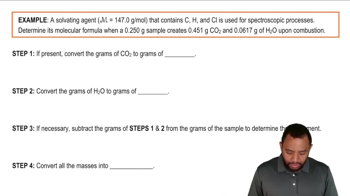Here are the essential concepts you must grasp in order to answer the question correctly.
Spectroscopy
Spectroscopy is a technique used to measure the interaction of light with matter. It involves analyzing the light emitted, absorbed, or scattered by substances to identify their composition and concentration. In the context of monitoring NOx conversion, specific wavelengths corresponding to the absorption characteristics of NO, NO2, and N2 must be measured to track the reaction progress.
Recommended video:
Molecular Formula via Combustion Example
Wavelengths of Light
Different chemical species absorb light at specific wavelengths, which are determined by their electronic transitions. For NO and NO2, the relevant wavelengths typically fall within the ultraviolet and visible regions of the spectrum. Monitoring these wavelengths allows for the detection of the presence and concentration of these gases during the conversion process to N2.
Recommended video:
Frequency-Wavelength Relationship
Catalytic Conversion
Catalytic conversion refers to the process where a catalyst facilitates a chemical reaction, often lowering the activation energy required. In the case of NOx reduction, catalysts such as platinum or palladium can convert NO and NO2 into N2, a less harmful gas. Understanding the kinetics of this reaction is essential for designing an effective spectroscopic experiment to monitor the conversion over time.
Recommended video:




